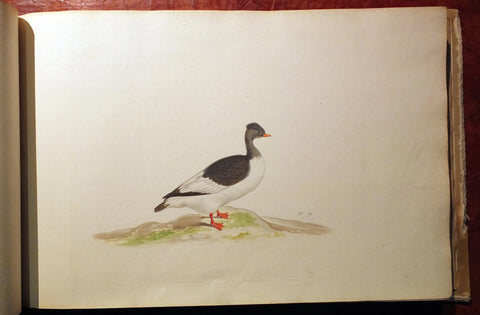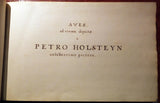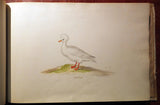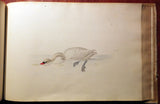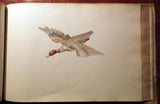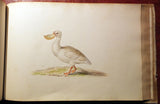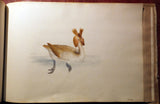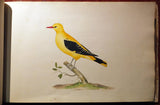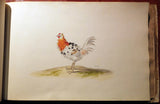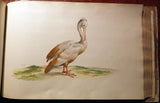Pieter Holsteyn The Younger (Dutch, 1614-1687), Aves aquatiles advivum eleganter depictae a Petro Holsteyn - Aves ad vivum depictae a Petro Holsteyn celeberrimo pictore.
PIETER HOLSTEYN THE YOUNGER (DUTCH, 1614-1687)
Aves aquatiles advivum eleganter depictae a Petro Holsteyn - Aves ad vivum depictae a Petro Holsteyn celeberrimo pictore.
Amsterdam: ca 1638
2 volumes, oblong folio (9 1/8 x 14 inches; 8 3/4 x 14 inches).
168 Exceptionally fine original watercolor drawings of birds of the Dutch Empire: The Netherlands, South Africa, Southeast Asia, and the Americas, Painted by the Premier Natural History Artist in the Netherlands of the time, Pieter Holsteyn II.
The only example of such an album in private hands. Drawn with superb naturalism: Birds are shown at rest, preening, flying, swimming and diving.
Volume I: 9 blank leaves, manuscript title-page, 79 fine original watercolor drawings of waterbirds, including ducks, geese, swans, heron, grebes, pelicans, puffins, penguins and auks, each initialed by Holsteyn “PH fc”, interleaved with blank leaves which are in 42 instances annotated in a contemporary hand with the name of the bird preceding it, 6 of the illustrated leaves are similarly annotated lower right, and many of the leaves, both illustrated and blank have partial manuscript page numbers in the center of the top edge, followed by a further 16 blank leaves, watermarked crowned Stasburg lily WR for Wendelin Riehel, according to Churchill created from 1636, (the last of which is torn with loss to the fore-edge);
Volume II: 7 blank leaves, manuscript title-page, 89 fine original watercolor drawings of shore-birds, herons, songbirds, exotic pheasants, peacocks, hummingbirds, birds of paradise, cockerels, toucans, spoonbills, parrots, cockatoos, parakeets and one of the earliest depictions of a DODO, each initialed by Holsteyn “PH fc,” interleaved with blank leaves which are in 66 instances annotated in a contemporary hand with the name of the bird preceding it, many of the illustrated leaves are similarly annotated lower right, 10 blank leaves.
Uniformly bound in near contemporary full Dutch vellum over paste-board, each cover decorated in panels with gilt filets and decorated at the innermost corners with tulip and rose tools surrounding a central arabesque medallion, the spines in five compartments with four raised bands, the titles in the second, the others decorated with fine gilt rose tools, all edges gilt (volume I worn with loss to the spine an upper left-hand corner of the front cover, edges gnawed by rodents, each lacking two pairs of green silk ties).
Provenance: Sotheby’s London, February 13, 1985, private sale from the estate of The Hague bookseller, Meyer Elte. Acquired by A. Alfred Taubman at the foregoing sale; his sale Sotheby’s New York, 14th December, 2015, lot 55. (See extensive notes below for early history of these volumes.)
Roger Pasquier, ornithologist and art historian has written of the Holsteyn albums:
“The 168 paintings depict 81 species and another 30 hybrids and avicultural varieties... Each painting is a portrait showing a single bird in – with a few exceptions – full profile. Some face left, others right. The birds and their simple landscape base are each about 7 by 8 inches, a few larger. The wild birds include many common in the Netherlands as well as a wide range of species from other hemispheres where the Dutch had established colonies and trading posts. The portraits of avicultural varieties reveal an interest in experimentation in hybridizing different wild birds, especially ducks, and in selecting for unusual features in parrots and in barnyard fowl. The album depicts a remarkable number of albino birds, from peafowl and pheasants to ducks, that – long before any formal knowledge of genetics – were the result of very selective breeding.
"The bird portraits also reflect a youthful curiosity and perhaps even a prankish spirit; a few of the birds are unidentifiable, either imaginary or clearly composites of different species that could never have met. We can also distinguish by their posture or animation the birds Holsteyn would have known in life, either by common observation or visiting a private menagerie, from those he drew from stuffed specimens that must have been part of a specialist’s collection.
“Holsteyn was not a ‘natural philosopher,’ as investigators into the world of Nature were then called. Unlike his contemporaries who published multi-volume series about birds, highly illustrated and with extensive texts, the absence of any text suggests Holsteyn did these paintings for private delectation by a knowledgeable owner” (see Mr. Pasquier’s complete essay below).
When Cornelis de Houtman returned home to the Netherlands in mid-January of 1597 after a successful voyage around the Cape of Good Hope into the Indian Ocean and back, the effect was dramatic and world changing, resulting in the opening of the spice rich East Indies to the Dutch spirit of enterprise, and the filling of Dutch coffers. By 1602 all the different competing Dutch companies sending trading fleets to the region had combined to form the Vereenigde Oost-Indische Compagnie, or V.O.C, the Dutch East-India Company, and it wasn’t long before the VOC received from the States General the privilege of the trade monopoly for Asia. With a fleet of over 100 ships, a workforce of ten thousand employees in offices, shipyards, and warehouses in the Netherlands as well as overseas, a maritime empire was born, which eventually extended from the Cape of Good Hope to Japan.
Over the 200 years of its existence the VOC established outposts in many locations along the shores of the Indian Ocean and the Far East, varying in character and function, differing in size, political significance and economic importance, diverse in language, culture, religion, and politics. In established empires, like India, China and Japan, the VOC was simply a merchant company. In other countries (the Indies archipelago and Ceylon), the indigenous political power was sometimes so fragmented that the VOC could wield direct territorial power through conquests. The VOC “was also permitted to wage war within its patent area on behalf of the States General and to conclude contracts with the indigenous sovereigns. For the purposes of strengthening and protecting its trade interests, the VOC was allowed to build forts and factories for its trade network...with the Indian archipelago at its centre” (Gunter Schilder & Hans Kok “Sailing for the East”, pages 45-46).
The extraordinary watercolors of birds found in these albums were drawn from specimens, dead and alive, brought back from all the realms of the Dutch empire; as such it represents the earliest known depiction of birds from around the world in one work: including an exceptionally rare and very important early depiction of a white dodo, one of only a handful known.
“The allure of these albums is in their hints of what might have been in the collection of a seventeenth century Dutch ornithological connoisseur who enjoyed experimenting in creating crosses between natural species, familiar and exotic, as well as in studying the specimens carried from distant outposts of the growing Dutch trading empire. The scale of the collection and the nature of the commission to Holsteyn suggests its owner was prosperous, perhaps even a shareholder in the very profitable Dutch East India Company that brought back new and unknown birds, both alive and as specimens.
The birds from other parts of the globe help document the pace of Dutch exploration. North America is represented by two species, a male and female Northern Cardinal (Cardinalis cardinalis) and a male Scarlet Tanager (Piranga olivacea). Nieuw Amsterdam was founded in 1623, but cardinals, which can easily be kept in cages, are found south to Mexico and must have been brought back to Europe long before. Ulisse Adrovandi features a very alert looking male in his “Ornithologiae hoc est de avibus historiae” of 1600, a widely circulated reference that organized birds by habits and anatomy and depicted them in woodcuts. Holsteyn and his patron might have known the book – but would not have needed it to know a cardinal. The tanager, a consumer of insects and fruits that would have been common in the forests of Manhattan during spring and summer, would however have been harder to keep and transport across the Atlantic than a seed eater like the cardinal. Holsteyn more likely worked from a specimen in the male’s breeding plumage of scarlet with black wings and tail, which the bird wears only from February or March through July.
The Dutch established a colony on the northeast coast of South America, what was then known as Guiana, and is now called Suriname. Perhaps from here came the specimens of two hummingbirds, not precisely identifiable, because the females of so many species are very similar. More distinctive is Holsteyn’s Burnished-buff Tanager (Tangara cayana), a widespread species that takes to gardens and other scrubby areas and would have adapted easily to whatever areas the Dutch colonists cleared. Holsteyn must have drawn his from a specimen, poorly prepared, since he shows it much longer and thinner than this chunky bird is in life. More puzzling is his toucan. Holsteyn depicts it twice – once as a portrait of the head with its distinctive long bill, and once in full. The bird’s bill has the pattern of the Black-necked Aracari (Pteroglossus aracari), but the combination of white underparts and tail banded in black and white is like no known species. The toucan would have been a poor traveler, and was probably drawn from a specimen. Perhaps all Holsteyn had was the head, which he painted separately, and imagined the rest of the body.
Africa is represented by a male and female Gray Crowned Crane (Balearica regulorum), found in South Africa. Another puzzling bird in the album may also be African, a slim red bird with a black head and longbill hooked at the tip. It most closely resembles the Carmine Bee-eater (Merops nubicus), widespread from West Africa across the continent to Kenya. Specimens may have been brought back from ports like Dakar, which was claimed by the Dutch intermittently between 1588 and 1664. Holsteyn’s bird, however, lacks the characteristic elongated central tail feathers, and he gives it white stripes on the base of the bill and across the upper back, which are not found on any red bird from any part of the world.
The Dutch quickly followed the Portuguese to establish trading posts in the East Indies, sources of valuable spices such as cinnamon, cloves, pepper, and nutmeg. Distinctive birds from this region of many islands came back as stuffed specimens with the spices. Holsteyn had access to three. The Black Sunbird (Nectarinia aspasia) is widespread from the Sulawesi group of islands through the Moluccas and east to New Guinea and Melanesia. A tiny bird (4 ½ inches), it uses its long bill to probe into flowers for nectar and insects. The bright, iridescent blue and black plumage would have made it attractive to collectors bringing novelties back to the Netherlands. At least two species of birds of paradise, both unique to New Guinea, also came as specimens and were painted by Holsteyn. The male Greater Bird of Paradise (Paradisea apoda) has long display plumes growing out of its lower back that it raises and fans when it displays before females. The male King Bird of Paradise (Cicinnurus regius) is brilliant red with two central tail feathers that are like wires extending well beyond the rest of the tail and tipped in green disks. The native peoples of New Guinea use feathers from these and many other birds for ceremonial headdresses and other ornaments. They also collected specimens for selling or trading purposes. These were typically prepared by removing the legs; when Europeans first saw these dazzling birds, they concluded that the birds must spend their entire lives on the wing in paradise, hence their name. The birds must have been common in the trade with Europeans, because these two species were depicted in 1657 by Kaspar and Matthaeus Merian in “Historiae naturalis de avibus”, by Joannes Jonstonus – but flat on their back, as they must have been packed, not alive as Holsteyn attempted. Matthaeus is best known as the father of Maria Sybille Merian, who in 1705 published a beautifully illustrated volume on the insects of what was then Dutch Guiana.
The most globally comprehensive family in Holsteyn’s album is the parrots. These birds were always admired for their bright plumage, familiar ways, and the ability of some species to imitate human speech. Some from India were already known to the Romans, but the maritime exploration of the world brought many more to Europe. Columbus carried macaws and other parrots back from the Caribbean islands and the American mainland. Many parrots would have been easy and companionable travelers, and a good investment for sailors who were willing to part with them on returning home. Holsteyn depicts ten species and a few in variant plumages, showing us that aviculturists already had a few generations of parrots with which to experiment.
From the Caribbean islands came the Rose-throated Parrot (Amazona leucocephala), found on Cuba, the Cayman Islands, and Abaco and Great Inagua in the Bahamas. In the seventeenth century, it may have been more widespread, before island forests were cut. Holsteyn paints the bird twice, in profile and from the back. Perhaps his subject was moving about on its perch. Macaws – so much larger and more brilliantly colored than any parrots Europeans previously knew – were among the first birds brought back to Spain and later other countries from the mainland American tropics. A red macaw appears in the background of a wedding portrait of Mrs. Johannes Cuspinian done by Lucas Cranach in Vienna in May 1502, only nine years after the first macaws would have reached Spain. By the seventeenth century, macaws of several species were widely kept in menageries and appear in many paintings, from scenes of Adam and Eve in the Garden of Eden to assemblages mixing familiar and exotic birds in large landscapes and still lifes. Holsteyn depicts a Blue and Yellow Macaw (Ara araruana), a Scarlet Macaw (A. macao), and another Scarlet with some unusual yellow feathers. While Holsteyn’s macaws may have been descendants of birds brought long before from Spanish or Portuguese possessions in the New World, his two paintings of a Brown-throated Conure (Aratinga pertinax) may have portrayed a bird carried from a Dutch colony. This species has a wide range in northern South America and adjacent islands; populations in different areas have evolved fourteen distinct plumages. Holsteyn’s bird is most similar to that of Curacao, first occupied by the Dutch in 1634. The Grey Parrot (Psittacus erithacus) of west and central Africa is considered the best mimic or talker of the world’s more than three hundred parrot species. It must have been one of the first known and regularly bred in Europe. The direct gaze of the bird Holsteyn painted twice, in profile and from the front, suggests he was working from a live pet. Also from west and central Africa – but perhaps also long raised in captivity – is the Red-faced Lovebird (Agapornis pullarius) Holsteyn painted in profile and again from the rear, all the better to show its distinctive red-banded tail, which the bird has spread in display. Usually inseparable from their mate, hence their name, wild lovebirds often fly long distances in larger flocks, searching for crops of seeds and fruit. They have the endearing habit of sleeping while hanging upside down. Both the lovebird and the Grey Parrot would have been widely available to Dutch traders in the ports of the Gulf of Guinea.
The Rose-ringed Parakeet (Psittacula krameri) has a broad range in two continents, across the middle of Africa and on the Indian subcontinent east to Myanmar. It is common in cities like New Delhi and has been introduced over the centuries to Middle Eastern cities like Baghdadand Teheran. This is likely to have been the first parrot brought to the Mediterranean region in ancient times. It also appears in the trees of gardens in Mughal miniatures. So it is appropriate that Holsteyn depicted it twice, in left and right profile.
East of India, the Spice Islands, as the Dutch thought of them, and New Guinea are home to a tremendous variety of parrots. Given the interest Holsteyn’s patron had in albinos, it is not surprising that the album contains portraits of three species of parrots that in nature are almost entirely white. The Sulphurcrested Cockatoo (Cacatua galerita) is widespread in New Guinea and eastern Australia, and was probably domesticated and traded farther west in ports of today’s Indonesia, where the Dutch spent more time. Holsteyn shows it with the yellow crest raised. A very similar bird, with some red on a few of the crest feathers is closest to the unique Sumba Island race of the Yellow-crested Cockatoo (C. sulphurea citrinocristata), which, unlike other populations of this species typically has an orange, not yellow, crest. Sumba, known for its sandalwood, is an island midway between Java and Timor. The third of Holsteyn’s cockatoos, the Tanimbar Corella (C. goffiniana), restricted to the islands of that name, a small cluster between easternmost New Guinea and northern Australia, demonstrates again the comprehensive trading links the Dutch established throughout the complex archipelago east of Borneo” (Roger Pasquier).
PROVENANCE: Between 1940 and the early 1980s the whereabouts of this album remained unknown, but much continued to be written about it in connection with the image of the white DODO found amongst the other exquisite watercolors of exotic birds. For many years art and natural historians have argued over why Pieter Holsteyn, and other artists should have chosen to paint the bird white.
Hume and Cheke in their “The White Dodo of Reunion Island - Unravelling a Myth”, 2004, ascribe Holsteyn’s image to his having seen Roelant Savery’s “Landscape with Orpheus and the animals”, ca 1611, which includes a very distinctive white Dodo, probably a specimen in the collection of the Holy Roman Emperor, Rudolph II, in Prague, described by Daniel Froschel in his inventory of the imperial collection.
The very first published image of the much loved and now extinct Dodo appeared as the second engraving in Jacob Cornelisz van Neck’s (1564-1638), “Le second livre, Iournal ou comptoir”, of 1601. The sailors of this voyage, and of subsequent ones, found the bird most interesting as food: flightless, and therefore easy to catch, but apparently not very tasty. They described the birds as ‘wallowbirdes’, ‘wallow’ coming from the Middle-Dutch word meaning tasteless, insipid, or sickly.
Pieter Holsteyn the Younger was a Dutch glass painter and engraver from Haarlem who worked also in Zwolle and Munster. He was trained by his father, Pieter Holsteyn the Elder (ca. 1580/90–1662).
THE EARLY HISTORY OF THESE VOLUMES:
Jolyon C. Parish in his “The Dodo and the Solitaire: A Natural History”, describes these Holsteyn albums: “The dodo, in watercolour, is illustrated in one of two oblong-folio, parchment-bound books with fine gilding and entitled “Aves aquatiles ad vivum eleganter depictae a Petro Holsteyn celeberrimo Pictore”. These contain over 180 bird illustrations.
“An undated picture of the dodo said to be by Pieter Holsteyn, was stated to be in the possession of A. van der Willige [sic] at Haarlem (Newton 1875-1889). A.C. Oudemans contacted A. van der Willigen at Velp, son of the Haarlem art expert, but his father had died and he was unable to provide Oudemans with any information regarding the dodo image. On contacting the firm Frederik Muller & Co. of Amsterdam, Oudemans found that Cornelis Hofstede de Groot at The Hague had previously sent a volume of Holsteyn’s drawings for appraisal. De Groot notified Oudemans (on May 24, 1916) that the album was in the possession of Mr. A.A. van der Feltz in Amsterdam.
“The images were formerly part of the inheritance of Jan Hendrik Baron van Lijnden van Lunenburg (1765-1854) in Utrecht. Arend Anne Baron van der Feltz (1862-1940) of Amserdam had married into the family, and he wrote to Oudemans on May 18, 1916, that the books were indeed in his possession - including the plate of the dodo, referred to as Dodaers. On May 27, 1916, Oudemans examined the painting and had a photograph made. Anon. (1937) mentioned the Holsteyn dodo picture as being in Amserdam but after 1940 the whereabouts of the dodo picture were unknown (Valledor de Lozoya 2003).
“However, the illustrations came to light once again. According to Den Hengst, they belong to ‘an old [Dutch] baroness who hid them in a pan under her sink cupboard, only to have them found by her children and sold to an antique dealer in The Hague, where the pictures were copied. Not long afterwards, the books were sold an anonymous buyer in London” (2003, 99). The dodo picture was in the possession of antiquarian bookseller Meijer Elten when Den Hengst photographed it, but the family sold the works after Elten’s death (Jan den Hengst, pers.comm., December 7, 2007). Elten had purchased the books from Rutgers van Rozenburg, who had inherited them from the baroness (Jan den Hengst, pers. comm., September 18, 2008). Later, the two volumes were to be found in the possession of Adolph Alfred Taubmann, former chairman of Sotheby’s.
“No date is given in either Vogel boek, but Oudermans (1917b) thought it probable that the illustration was derived from the same bird as in the Teylers image, and dated it to around 1638” (pages 153-154).
OTHER EXAMPLES OF HOLSTEYN’S WATERCOLOR OF THE DODO
THE TEYLERS MUSEUM EXAMPLE:
An extensive album of watercolor drawings by Holsteyn, including images of birds and flowers, is recorded in Biesboer and Togneri’s “Collections of Paintings in Haarlem, 1572-1745”. Getty, 2001, as part of the bequest of Miss Fancona Antoinetta Conradina van der Burch (1813-1888), who left it to the Haarlem Gemeente Archief in 1888. Two plates of a Dodo and of a duck, from that album, which had been given to Christina Abigael van der Willigen of Laren (Noord-Holland), were subsequently donated to Teylers Stichting, Haarlem, in 1916, where they are now on display.
The history of the provenance of the van der Willigen album is given in Jolyon C. Parish’s “The Dodo and the Solitaire: A Natural History”, page 152:
On December 30, 1865, “Volkert Simon Maarten van der Willigen of Haarlem read a paper before the Koninklijke Academie van wetenshapphen (Afdeeling Natuurkunde) and exhibited a copy of a colored picture of a Dodo by Pieter Holsteyn from a bird book of paintings belonging to a Haarlem art enthusiast (Van der Willigen 1866). The book, containing over 100 bird pictures, was an oblong folio bound in parchment (Renshaw 1938). Van der Willigen noted that there must have been a second book with paintings by Holsteyn in the Netherlands, also containing a picture of the dodo, but that the whereabouts were unknown. J.J. Verwigjnen, librarian at Haarlem, wrote to A.C. Oudemans on June 9, 1916, stating that Holsteyn’s bird book was at that time the property of the municipality of Haarlem, but that there was no dodo plate. A week later, Oudemans received further information from Verwijnen, that Jan Louis van der Burch (1811-1886), burgemeester of Haarlemmerliede and Spaarnwoude, owned Holsteyn’s bird book, which consisted of loose plates. The book, containing the other bird plates, came to Van der Burch’s sister, Miss Fancona Antoinetta Conradina van der Burch (1813-1888), who left it to the Haarlem Gemeente Archief in 1888; her niece’s husband Adriaan Justus Enschede, was the executor. As for the dodo picture, Van der Burch had given it to Adriaan van der Willigen Pz. of Haarlem (1810-1876) c. 1865 (Plomp 1997). Van der Willigen’s collections were sold in 1874-1879, but there was no mention of a dodo plate in the catalogs. Dr. Van der Willigen wrote to Oudermans on June 24, 1916, that the Holsteyn plate was in the property of his sister, Christina Abigael van der Willigen of Laren (Noord-Holland). On Oudermans’s recommendation, Christina van der Willigen donated the dodo plate, along with another depicting a duck (Anas boschas) with a pathologic bill, to Teylers Stichting, Haarlem, in 1916”.
THE NATURAL HISTORY MUSEUM, LONDON, EXAMPLE
The Natural History Museum in London has in its collection a watercolor of a white dodo by Pieter Holsteyn the younger. “The picture was purchased in a sale at the saleroom, Doelenstraat, Amserdam (Collection ‘S’), one of the 145 bird illustrations by various artists), on December 7, 1908, by Hans Wertheim, who sold it to the Trustees of the BMNH on January 19, 1937 (Anon. 1937; Renshaw 1938; Ann Datta, pers. comm. to Pierre Brial, 1998 [see Brial 200]). According to Jackson, it was ‘acquired from an Amsterdam dealer who said it was in a collection of different birds by Pieter Holsteyn the elder” (1999, 291). (Jolyon C. Parish “The Dodo and the Solitaire: A Natural History”, page 153).
Currently in the collection of Graham Arader, who remarks that during the 17th-century, “the Dutch never once lost a naval battle during the entire century. They had the whole nation of France severely trapped because of the French love of great food. The Dutch drained France of cash because the French could not live without mace, cloves, nutmeg, pepper, cinnamon and other spices for their meals. There is practically a Dutch monopoly because the Dutch had 99% control of spice islands in the Indian ocean. Even today they control this trade. This is the reason that all voyages to America were initially made to find a way to get to the Spice Islands faster. “This book is the essence of their obsession with detail - to fully understand the natural history of the lands they were exploiting to make money. They had roughly 70 trading posts around the world of which Manhattan was one. These watercolors are their finest production in this area, and they show birds from around the world, together, for the very first time.” - Graham Arader
The first printed ornithologies are found in Aristotle and Pliny, containing information that was reiterated by subsequent authors with extra comments. These works would usually describe the birds, where they might be found, whether they were edible, if they had any medicinal value, and what their human traits and characteristics were. It was also not uncommon to find mythical and fabled birds such as the phoenix and griffin amongst the pages of such works. The first ornithological book illustrated with woodcuts was a folio volume in seven parts, entitled “L’histoire de la nature des oyseaux, avec leurs descriptions & naifs portriacts retirez du nature”, by Pierre Belon (1517-1564). It was essentially a compendium, which like its predecessors borrowed from Aristotle and other classical authors. Like Aristotle, Belon divided birds into categories based on structure and ecology; but unlike Aristotle’s arrangement, “Belon’s is clearly an attempt at classification, infused with Belon’s own observations... Belon must be regarded as a forerunner of the comparative anatomists of the eighteenth and nineteenth centuries” (“Wrought in the Margin: the age of handmade illustrations and woodcuts” page 32-33 of “Masterpieces of Bird Art”, by Roger Pasquier and John Farrand, Jr., 1991).
The Holsteyn album shows birds only found wild in nature, and in menageries, with an attempt at coherent organization. The first volume contains waterbirds, grouped by likeness, the second volume exotic birds, similarly arranged. It is clear that Holsteyn was inspired by the work of his predecessors: Pierre Belon’s (1517-1564) L’histoire de la nature des oyseaux, avec leurs descriptions, & naifs portraicts retirez du naturel. Paris: 1555; and Ulisse Aldrovandi’s (1522-1605) three volume ornithology Ornithologiae... libri XII. Bologna: 1599, and Ornithologiae tomus alter. Bologna: 1600, Ornithologiae tomus tertius ac postremus. Bologna: 1603. While Holsteyn’s artistry is far superior to that of both Belon and Aldrovandi, and he includes in his album a great number of new species collected from throughout the Dutch empire, there are two paintings of birds in which Aldrovandi’s influence can be seen directly: the Toucan, and the birds which are captioned in the album as Pelicans. One image captioned in an early hand, ‘Wort een pellicaen genoemt,’ shows a fanciful waterfowl with the head of a hawk, and follows closely Aldrovandi’s Corpus Christi, the allegorical depiction of a Pelican piercing its own breast to feed its young, page 47 of Ornithologiae tomus tertius ac postremus. By including images that are allegorical and fanciful in his albums, Holsteyn not only follows the examples of his predecessors, but is part of a tradition continued by his successors. Aldrovandi, who had an eye for the macabre includes creatures with human heads and birds bodies in his Ornithologiae, and Belon Mermen and Horses with fishy tales in his De aquatilibus of 1553. Seba in his Locupletissimi Rerum Naturalium Thesauri. Amsterdam: 1734-1765, famously includes a many headed Hydra, and John Jonston (1603-1675) includes many plates of nearly a douzen distinct species of Unicorn, Gryphons and other curiosities from throughout the animal kingdom in his Historiae naturalis de... series 1632-1662.
As the study of natural history progressed into the latter half of the 17th and early 18th-centuries, the standards of ornithological works improved, but birds continued to be grouped together by habitat and then by their actions. Walter Charleton’s (1619–1707) system, explained in his Onomasticon zoicon (London, 1668), involved looking at the birds’ diets, whether they bathed (and in what water/sand) or sang.
“The way birds were ordered changed with the publication of Willughby’s Ornithology (London, 1678). Firstly, they are classed here as land or water birds. The land birds are then divided into those with crooked beaks and claws and then those with straight beaks. The water birds are divided into those ‘that wade in the waters, or frequent watery places, but swim not; The second, such as are of a middle nature between swimmers and waders, or rather that partake of both kinds, some whereof are cloven-footed, and yet swim; others whole-footed, but yet very long-leg’d like the waders: The third is of whole-footed, or fintoed Birds, that swim in the water’. This is thought to be the first attempt to classify birds rationally” (The Whipple Library: University of Cambridge online).
VOLUME I:
Goosegander (Common Merganser) (Mergus merganser) male
Black Scoter (Melanitta nigra) female
Barnyard goose
Goldeneye hybrid (Bucephala clangula x ?)
Barnacle goose (Branta leucopsis)
Brant (Branta bernicla) dark-bellied form
Brant (Branta bernicla) “Een Rotgans” dark-bellied form
Bar-headed Goose (Anser indicus) “Een Oost-indise Gans” immature hybrid domesticate duck “Een Gans”
Egyptian Goose (Alopochen aegyptiacus) “Een gans vande Caep de bona Esperanza” Duckling (Anas species)
“Een Eende kuyken”
Domestic Top-Knot duck “Kuys Eendt”
Gadwall x Mallard hybrid (Anas strepera x A. platyrhynchos)
Mallard (Anas platyrhynchos) female
Mallard (Anas platyrhynchos) male
Mallard (Anas platyrhynchos) male
Common Shelduck (Tadorna tadorna)
Muscovy Duck (Cairina moschata) “Een Oostindische Eendt” albino
Common Shelduck (Tadorna tadorna) “Een Bersch eendt” female
Muscovy Duck (Cairina moschata) “Een Oostindische Eendt”
Gadwall - Mallard hybrid (Anas strepera x A. platyrhynchos)
Garganey x Common (Green-winged) Teal hybrid (Anas querquedula x A. crecca)
Common (Green-winged) Teal (Anas crecca) “Pijptaling Wijfie” female
Common (Green-winged) Teal (Anas crecca) “Pijptaling Mannetie” male
Eurasian Wigeon (Anas penelope) “Een Smient Wijfie” female
Eurasian Wigeon x Common (Green-winged) Teal hybrid (Anas penelope x A. crecca) “Een Smient Mannetie” male
Gadwall (Anas strepera) “Een kraeck Wijfie” female
Gadwall x Common (Green-winged)Teal hybrid (Anas strepera x A. crecca) male
Pied Avocet (Recurvirostra avosetta) “Een Sluyf”
Black-headed Gull (Larus ridibundus) “Een bonte Meeu” immature
Great Crested Grebe (Podiceps cristatus) “Een Duigel Hooschduytse Vogel”
Atlantic Puffin (Fratercula arctica) “Een Yslantse Vogel”
Razorbill (Alca torda)
Bar-headed Goose (Anser indicus) immature
Red-breasted Merganser (Mergus serrator) female
Red-breasted Merganser (Mergus serrator) female
Brant (Branta bernicla)
Garganey hybrid (Anas querquedula x ?)
Barnacle Goose (Branta leucopsis) “Een Brantgans”
Mute Swan (Cygnus olor)
Red-throated Loon (Gavia stellata) winter plumage
Arctic Tern (Sterna paradisea) “Een Meeu”
Gadwall (Anas strepera) “Eeen kraeck”
Male penguin species “Pinguin in de Straet Magellanes”
Hybrid duck “Een Indiaense Vogel daer men de Vissen mede vangt”
Pied Avocet (Recurvirostra avosetta) “Een Sluyf”
Eurasian Wigeon (Anas strepera) female
Barnacle Goose (Branta leucopsis)
Domestic goose with deformed bill
Whiskered Tern (Chlidonias hybrida)
Pied Avocet (Recurvirostra avosetta)
Red-breasted Merganser (Mergus serrator) male
Albino duck
Mute Swan (Cygnus olor)
Great Crested Grebe (Podiceps cristatus)
Tufted Duck (Aythya fuligula) “Lommetiys Een Groenlantse Vogel”
Little Auk (Dovekie) (Alle alle) “Een Naers Voedt”
Common Merganser (Mergus merganser) female
Fanciful white waterfowl with the bill of a hawk “Wort een pellicaen genoemt” (captioned in the image)
Mallard (Anas platyrhynchos) male
Smew (Mergus albellus) “Een Witte Duycker”
Gadwall (Anas strepera)
Shoveller (Anas clypeata) “Een Slob Wyfie”
Shoveller (Anas clypeata) “Een Slob Mannetie”
Tufted Duck (Aythya fuligula) “Een Topper”
Northern Pintail (Anas acuta) “Pylstaert Wyfie” female
Northern Pintail (Anas acuta) “Pylstaert Mannetie” male
Smew (Mergus albellus) “Een Scherf”
Gadwall (Anas strepera) “Een kraeck Wyfie” female
Gadwall (Anas strepera) “Een kraeck Mannetie” male
Common (Green-winged) Teal (Anas crecca) “Pijptaling Wijfie” female
Common (Green-winged) Teal (Anas crecca) “Pijptaling Mannetie” male
Garganey (Anas querquedula) “Een Schyftaling wyfie” female
Garganey (Anas querquedula) “Een Schyftaling, of Somertaling Mannetie” male
Eurasian Wigeon x Common (Green-winged) Teal hybrid (Anas penelope x A. crecca) “Een Smient” male
Common Shelduck (Tadorna tadorna) “Een Bersch Endt”
Pied Avocet (Recurvirostra avosetta)
Mute Swan (Cygnus olor) “Swaen” (captioned in the image)
Barnacle Goose (Branta leucopsis) “Een Brant gans”
VOLUME II:
Moorhen (Gallinula chloropus) “Een Waterhoen”
Ruff (Philomachus pugnax) “Een Kemphaen”
Ruff (Philomachus pugnax) “Een Kemphaen”
Ruff (Philomachus pugnax) “Een Kemphaen”
Brambling (Fringilla montifringilla)
Common Buzzard (Buteo buteo)
Redwing (Turdus musicus) “Een bonte Lyster”
Golden Oriole (Oriolus oriolus) “Wiewael Wyfie” female
Golden Oriole (Oriolus oriolus) “Een Wiewael Mannetie” male
Scarlet Tanager (Piranga olivacea)
Golden Oriole (Oriolus oriolus) immature
Black-crowned Night-Heron (Nycticorax nycticorax) “Een Quackrayger”
Barn Swallow (Hirundo rustica) “Een Swalef”
Wryneck (Jynx torquilla) “Een Specht”
“Een Specht” - excised
Green Woodpecker (Picus viridis) “Een Groene Specht” female
Great Spotted Woodpecker (Dendrocopus major) “Een Specht” male
Great Spotted Woodpecker (Dendrocopus major) “Een Specht” male
Green Woodpecker (Picus viridis) “Een Specht. Note-desen vogel heest aen de voeten twe klawen voor,
en twaklawn achter, en de andre vogels hebber drie klawen voor, en een achter” (Green Woodpecker, with claws on its feet facing both directions) male
Common Crane (Grus grus) “Kraen Wyfie” immature
Common Crane (Grus grus) “Een Kraen mannetie” male
Common Crane (Grus grus) “Een Kraen Mannetie” male
“Een Foort van een Hawik” - excised
Cockerel
Cockerel
Cockerel
Cockerel
Cockerel
Cockerel
Chick
“Een vaer Vogel in Oostindien krygt alle weren een kreeo op het bovenste
vande beck” - excised
Black-billed Magpie (Pica pica) “Een Exter”
Unnamed - excised
Dodo (Raphus cucullatus) “Een Dodaers”
Gray Crowned Crane (Balearica regulorum) “Een kroon Vogel Wyfie” female
Gray Crowned Crane (Balearica regulorum) “Een kroon Vogel Mannetie” male
White Stork (Ciconia ciconia)
Bullfinch (Pyrrhula pyrrhula) “Een Goudt Vinck Wyfie” female
Bullfinch (Pyrrhula pyrrhula) “Een Goudt Vinck Mannetie” male
Blue Peafowl (Pavo cristatus) albino female
Blue Peafowl (Pavo cristatus) albino female
Unnamed - excised
Common Cuckoo (Cuculus canorus) “Een Koekoeck” male
“Een Arent” - excised
“Een Spreeu” - excised
Black-necked Aracari (Pteroglossus aracari) “De kop van een Tokan” - the head of a toucan
Toucan resembling in part a Black-necked Aracari (Pteroglossus aracari) “Een Tokan”
Eurasian Spoonbill (Platalea leucorodia)
Great White Pelican (Pelecanus onocrotalus) immature
Eurasian Bittern (Botaurus stellaris) “Een Pittoor”
Eurasian Bittern (Botaurus stellaris) “Hern”
European Roller (Coracias garrulous) immature
Common Quail (Coturnix coturnix) “Een Quartel”
Grey Partridge (Francolinus pondicerianus) “Een Partrys”
Barbary Partridge (Alectoris barbara) “Een franse Patrys”
Willow Grouse (Lagopus lagopus) “Een Patrys Van Salee”
Rock Partridge (Alectoris graeca) “Een Wyfies Corhoen” female
Black Grouse (Lyrurus tetrix) “Een Manneties Corhoen” male
Ring-necked Pheasant (Phasianus colchicus) “Een Phesant” albino
Ring-necked Pheasant (Phasianus colchicus) “Een Phesant” albino
Ring-necked Pheasant (Phasianus colchicus) “Een Phesant” albino
Ring-necked Pheasant (Phasianus colchicus) “Een Phesant”
Ring-necked Pheasant (Phasianus colchicus) “Een Phesant”
Ring-necked Pheasant (Phasianus colchicus) “Een Phesant”
Black Partridge (Francolinus francolinus)
Northern Cardinal (Cardinalis cardinalis) “Een Virginise Nachtegael Wyfie” female
Northern Cardinal (Cardinalis cardinalis) “Een Virginise Nachtegael Mannetie” male
Unidentified hummingbird
Black Sunbird (Nectarinia aspasia)
Black Sunbird (Nectarinia aspasia)
Common Kingfisher (Alcedo atthis) “Een Ys Vogel”
Carmine Bee-Eater (Merops nubicus)
Burnished-buff Tanager (Tangara cayana) “Een Brasiliaense Vogel”
Black Grouse (Lyrurus tetrix) “Een Siams Hoen” male
Unidentified hummingbird “Gouberga. Oostinies [sic] Vogeltie”
Greater Bird of Paradise (Paradisea apoda) “Een Paradys Vogel Vroutie”
King Bird of Paradise (Cicinnurus regius) “Een Paradys Vogel Mannetie” male
Sulphur-crested Cockatoo (Cacatua galerita) “Een kacketoe”
Yellow-crested Cockatoo (Cacatua sulphurea) “Een Kacketoe”
Red-headed Lovebird (Agapornis pullarius) “Een Parakietie”
Red-headed Lovebird (Agapornis pullarius) “Idem”
Red parrot, no known species, “Een Parkiet”
Brown-throated Conure (Aratinga pertinax) “Een Parkiet”
Brown-throated Conure (Aratinga pertinax) “Een Parkiet”
Rose-ringed Parakeet (Psittacula krameri) “Een Parkiet”
Rose-ringed Parakeet (Psittacula krameri) “Een Parkiet”
“Een Papegaey” - excised
Tanimbar Corella (Cacatua goffiniana) “Een Papegaey”
African Grey Parrot (Psittacus erithacus) “Een Papegaey”
African Grey Parrot (Psittacus erithacus) “Een Papegaey”
Rose-throated Parrot (Amazona leucocephala) “Een Papegaey”
Rose-throated Parrot (Amazona leucocephala) “Een Papegaey”
Purple-naped Lory (Lorius domicella) “Een Lori”
Purple-naped Lory (Lorius domicella) “Een Lori”
Purple-naped Lory (Lorius domicella) “Een Lori”
Blue and Yellow Macaw (Ara araruana) “Een Indise Raven”
Scarlet Macaw (Ara macao) “Een Indise Raven”
“Een Indise Raven” - excised
“Een Indise Raven” - excised
“Een Indise Raven” – excised
We Also Recommend

